
You are reading the older HTML site
Positive Feedback
ISSUE
28
slim devices
Squeezebox 3 with Bolder Cable Digital and Power Supply Modifications - Shaking Some Sweet Sound Out of Your PC
as reviewed by Samuel Roberts
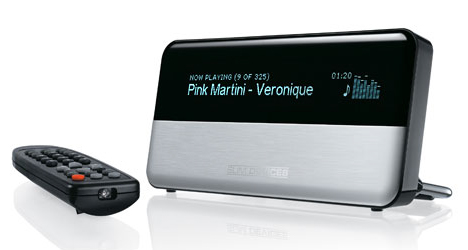
|
SAMUEL ROBERTS'S SYSTEM
LOUDSPEAKERS
ELECTRONICS
SOURCES
CABLES
ACCESSORIES
|
Wherever you go there you are…
I stumbled into computer based audio by way of using an iPod as my portable music player and if you are reading this chances are you did too since Apple has upwards of 80% of the retail market for MP3 players. The iPod is a fantastic device for portable audio, never skips, decent battery life in the newer versions, and when fed lossless or uncompressed files and run with some decent headphones sounds very good. When I got my first iPod I was geeked and thought it would be great to have this kind of convenience of organizing music in my main system. I quickly learned however, when hooked into my main rig for critical listening it sounded quite poor, and I could hear all its warts plainly when it was not competing with background noise in a car or plane. I began to investigate alternative means to get files from my computer to my main system and after researching the available options I decided to purchase the Squeezebox 3 based on the fact it had a decent quality DAC, excellent display and interface, and a coax SPDI/F digital output. At only $299 for the wireless unit it didn't seem like a big risk compared to many other components I have bought in a fit of lust and later divorced in disgust.
Squeezebox 3 ...Sexy Tech
Initially I was planning to use the Squeezebox to augment a traditional disc player for sheer convenience. I have owned a few quite nice sounding units including the Ayre CX-7e, Electrocompaniet EMC-1UP SE, and Arcam CD23, and I was using a Bel Canto PL-2 feeding a Benchmark DAC-1 at the time I purchased the Squeezebox with satisfactory results. I first tried using the analog outputs of the Squeezebox directly into my preamp, and while acceptable for background music, it did not have much life. Dynamics were poor, frequency extremes were missing, and there was a veil over the music. I moved on to feeding the Squeezebox's digital output to the Benchmark and this setup showed serious promise. Music emerged from a very quiet background and lacked any digital glare nearly equaling the overall performance of the PL-2/DAC-1 combo. When I factored in how nice it was to never have to leave my chair to change discs, the PL-2's time was up. Following it out the door of my listening room was my monstrous CD rack, no longer looming over me from the corner of my room like a tidal wave of jewel cases, and I was not sad to see it go.
Taking the Plunge
Having spent days ripping music via iTunes, I was now wed to my hard drive come hell or high water and it was time to get serious. Bolder Cable is based just fifteen minutes from my house so it was an easy decision to investigate their modification services for the Squeezebox 3. Bolder offers several types of mods including extensive analog output upgrades but since I was planning to use the digital output to feed my DAC-1 I requested only the digital mods be applied. I also purchased the Elpac regulated linear power supply that was recommended by Wayne Waananen the head honcho of Bolder Cables as they do not carry the unit, and once it arrived I gave him the Squeezebox and power supply to work his magic on. In the meantime I listened to my unmodified Squeezebox to get a good handle on its sound and prepare for a direct comparison.
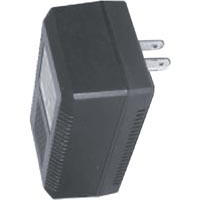
The glamorous looking Elpac power supply
Wayne's modifications to the Elpac power supply include replacing the stock diodes with HexFreds, replacing the smoothing cap with a higher capacity and higher quality Panasonic, replacing the reservoir cap with a very low ESR Panasonic FM series, and adding a Black Gate NX series cap as a bypass across the output of the regulator. Their Squeezebox 3 digital mod includes replacing many of the main input power supply capacitors and digital buffer power supply capacitors with higher value low ESR versions. BlackGate NX caps are used throughout the circuits. The power supply cap to the digital buffer chip is replaced by a BlackGate NX and the signal path to the digital output jack is rerouted. The digital output jack is replaced with a 75 ohm, WBT NextGen, gold plated, copper RCA. I don't know what a lot of this stuff does but it sure sounds good, and the new WBT connectors are fascinating to look at. The power supply mods will set you back $100 plus the cost of the Elpac, and the digital mods are $200 plus the cost of a Squeezebox, both prices exclusive of shipping.
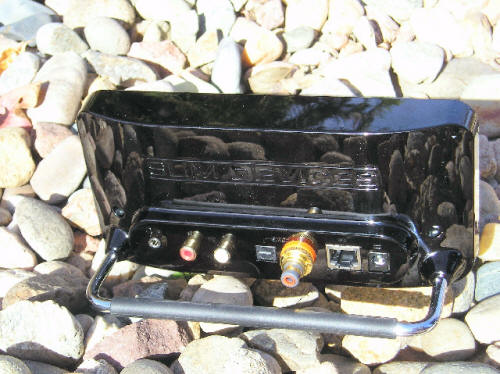
Wayne cautioned the modded unit would need some significant break-in to achieve its full potential. I found this to be true as for the first several days it actually sounded worse than the stock unit, lacking body and seeming somewhat harsh sounding. Since there are no moving parts to wear out I was not worried about leaving it on nonstop for over a week while I was out of town, and when I returned my patience was rewarded. The unit had taken on a lushness and body that was missing in the stock unit, and the weight and extension in the bass was much improved. I am not sure if I am a bass freak since no one has ever called me that before, at least not to my face, but I do like plenty of slam and extension during my frequent excursions into industrial and electronic music. The modified Squeezebox has excellent bass slam, and when I ramp up the volume on tracks like Goldfrapp's Black Cherry or Massive Attack's Mezzanine it delivers a physical as well as audible punch to the gut without loss of control or pace. Despite the increase in heft, acoustic bass and male voices were never overcooked, and overall coherency was improved.
In addition to the added low end prowess the midrange and treble gained greater aptitude and female vocals in particular became much more lifelike. Listening to Vienna Teng on Dreaming Through the Noise or Neko Case on Fox Confessor Brings the Flood, it seemed like I was listening to the performer and not a glossy facsimile as is often the case with digital sources, and the micro-dynamics of their voices came through more clearly. The midrange balance with the modded unit in my system leans to the warm side, but this is due in part to my Aesthetix Janus with new old stock tubes as well as the DAC-1 itself which is not quite as incisive or detailed in the midrange as it is in the treble and bass. I prefer an immersive and forward soundstage, and a pronounced midrange to mid-treble typically puts mud in my applesauce to say the least. The unmodified unit added an often times unpleasant emphasis to these frequencies, but depending on your tastes you may miss this energy on some tracks. Personally I much preferred the more polite presentation of the modified unit which reduced listener fatigue to a non-factor. I found the "spotlight" on some instruments and vocalists was less artificial with the modified unit and the image was larger both in width and depth offering a truly engaging listen.
In the upper registers the modifications allowed cymbals, bells, and synthesizer bleeps & braps both the detail and body required while avoiding the harshness and grain of the stock Squeezebox. My speakers have a ribbon super-tweeter and though the sound was smoother and easier to listen to it was very evident the zenith of treble extension was raised. On material such as the new self titled release by Rodrigo y Gabriela, the sound of their fingers on the guitar strings was perfectly integrated with the sound from the guitar body instead of being a distracting discombobulated noise. In addition the modifications lowered the noise floor allowing more air and ambience from the recorded space to be heard. I found I can now listen to many discs with a significantly lower gain and still hear all the detail and ambiance. The dreaded cliché of digital sounding "analog" is about the only thing I can say, the modified unit simply allows more high frequency detail with less fatigue than the stock unit.
So are there any other good options to get my tunes out of your PC if you don't want to spend this much dough?
I compared the stock and modified Squeezeboxes to two other methods of feeding my DAC to ensure I hadn't just fallen for the first gadget to catch my eye. First I ran the mini optical output from my Mac Mini to the Toslink input on the Benchmark. This setup was very lackluster at first and I was ready to give up after less than three songs, then I found you could output a 24/96kHz signal from the Mac by changing system settings. Moving from 16/44kHz to 24/96kHz was an enormous leap, and the 24/96kHz sound was very dynamic with good frequency extension and a decent soundstage. What kept the direct toslink connection from challenging the Squeezebox was a digital glare manifested as an annoying harshness in the upper mids and lower treble that made listening for more than a few minutes very uncomfortable. This harshness was more pronounced than on the stock Squeezebox, and coupled with the increased dynamics I found myself wanting to run for the door on several rock songs. While not without significant drawbacks in sound quality this setup was the value leader as the Belden mini optical to Toslink cable set me back $14.99, however an additional consideration is a controller. If you do not have a monitor in your listening room or some other form of controller for your software player, the Squeezebox is clearly a simpler way to manage your library. I utilized a PDA and the Salling Clicker software to control my iTunes without a monitor and it worked quite well, but again this is a more complex solution than the Squeezebox and probably not one to recommend for those who find programming a Tivo box akin to putting a man on Mars.
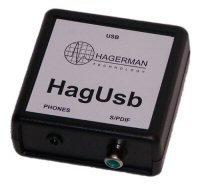
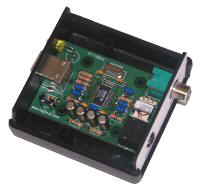
Next up was the Hagerman Technology HagUSB, a simple USB converter that outputs an SPDI/F signal. This device is quite inexpensive at $125 and can be made from kit form for even less. I found the sound of the HagUSB to be quite pleasing and it did not suffer from the harshness that plagued Mac's optical output. On discs like Goldfrapp's Black Cherry, the synthesized noises that were grating through the Mac's output were now tamed, and the soundstage was more laid back. The more I listened to the HagUSB however the more I found it was a bit too pleasant, obscuring detail and noticeably softening the attack and bite on many recordings. To be fair, the modified Squeezebox and power supply total out at over $600 while the HagUSB comes in at a fraction of that, so considering its overall musicality it could be a good option if budget is a concern or you just want to dip a toe into the PC audio ocean. Again one consideration is how to control your music as the HagUSB is simply a conduit to get the 0's & 1s out to your DAC. For some this is no big deal, for others it is a deal breaker as mentioned previously.
After evaluating all of these options, I found the Bolder modified unit was simply more dynamic with significantly fuller bass, a musical and less fatiguing midrange, and more delicate and extended treble. As a final hybrid test I also hooked the stock Squeezebox to the modded Elpac power supply and found this to give it a definite boost in dynamics and bass, but did not present the same liquidity or soundstage of the modded unit and the treble was still a bit zingy, so my advice is to go for the full digital mods.
So how good is it?
Based on my experience with the Bolder Cable modified Squeezebox I would say it is a spectacular bargain when you consider the sound quality it is able to extract from your hard drive. The beauty is you likely already have a PC of some serviceable sort, and if you have a wireless network you can put the Squeezebox anywhere in your home and have a reference caliber transport for very little investment. This truly appears to me to be the future of digital, and recently several very high-end hard drive based stand alone units have been introduced supporting the idea that the days of using physical discs are numbered. Others more technically literate than I have written volumes about the potential superior performance of hard drive as a source versus compact disc due to reduced jitter, error correction, and other benefits. It is also hard for me to fathom that I was able to replace an entire wall of CDs with an external hard drive the size of a dictionary, and a 40 pound player with a unit the size of a box of Mac n' Cheese and not lose sound quality in the process.
PC Man moves into Appleville...
I admit the main reason I bought an Apple Mac Mini is aesthetic, the thing is tiny, and it is also almost dead silent. It is also the simplest computer I have ever used and given my full acceptance of iTunes it was an easy choice for a dedicated music source. Now for some controversy, I have ripped several discs in both Apple Lossless Compression and as uncompressed files and found I could not reliably tell the difference so to save disk space most of my collection is encoded in ALC. This probably causes some ruffling of feathers as some feel there is a sonic compromise despite the fact that it has been proven it truly is a lossless technology, and also because others don't like being roped into using Apple's proprietary software. Without delving into those too deep, this underlines one of the strengths of the Squeezebox platform, it will decode pretty much any format under the sun, and Slim Devices has provided constant firmware updates to keep up with changes or reported glitches. For those in uncharted territory with ripping music, I have found iTunes to be the most user friendly program out there as it automatically categorizes and labels as you rip and its playlist feature is very simple to utilize (and its playlists can be utilized on the Squeezebox). I have used other programs on a Windows machine and although they often have more flexibility and advanced options, they are significantly more complex than iTunes for those who are not at least moderately skilled in PC geekery. No matter which path you decide to take, you will be surprised at the level of performance offered.
For anyone who has contemplated using hard drive based audio, I highly recommend the Squeezebox 3 with Bolder Cable Company modifications for the sheer ease of enjoying high quality digital music. It is great when I have an entire evening to spend with my vinyl allowing time for thorough cleaning and setup, however I find myself now sitting down to listen to several different artists for 20-30 minutes when in the past I would likely not have due to the inconvenience of selecting discs and warming up a player. Computer based audio is just coming into primetime for use in high-end audio and there are sure to be advances ahead, but the modified Squeezebox is a simple, affordable, and great sounding solution for anyone looking to break free from the shiny disc today. Samuel Roberts
Squeezebox 3 wireless
Retail: $299
Slim Devices
web address:
www.slimdevices.com
Bolder Cable Company Squeezebox Digital
Modifications
Retail: $200
Boulder Cable Company Elpac Power Supply
Modifications
Retail: $100
Bolder Cables
web address:
www.boldercables.com
Hagerman HagUSB SPDI/F Converter
Retail: $125
Hagerman Technologies
web address:
www.hagtech.com
